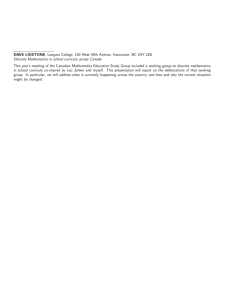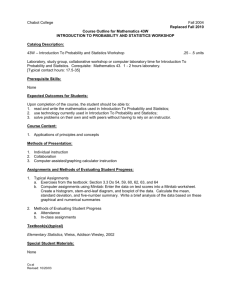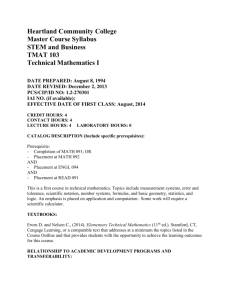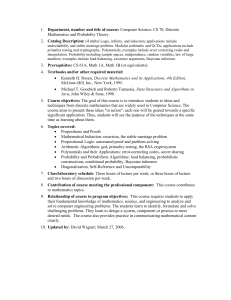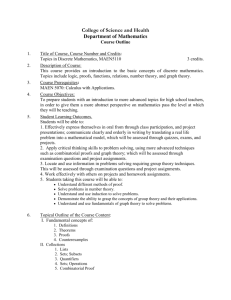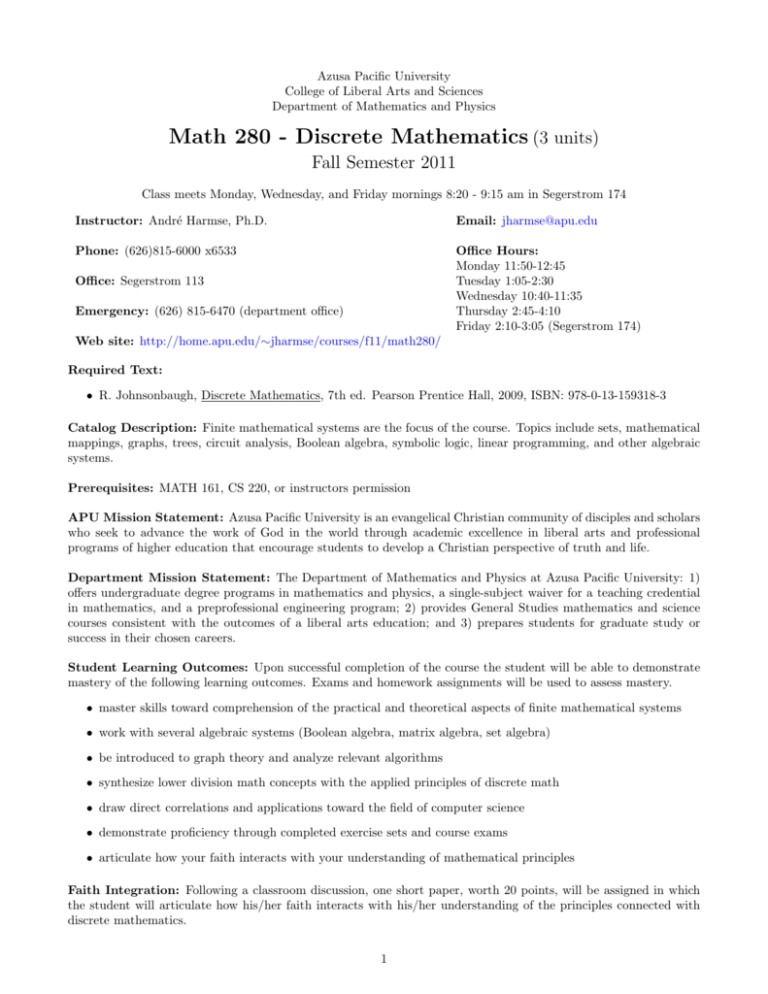
Azusa Pacific University
College of Liberal Arts and Sciences
Department of Mathematics and Physics
Math 280 - Discrete Mathematics (3 units)
Fall Semester 2011
Class meets Monday, Wednesday, and Friday mornings 8:20 - 9:15 am in Segerstrom 174
Instructor: André Harmse, Ph.D.
Email: jharmse@apu.edu
Phone: (626)815-6000 x6533
Office Hours:
Monday 11:50-12:45
Tuesday 1:05-2:30
Wednesday 10:40-11:35
Thursday 2:45-4:10
Friday 2:10-3:05 (Segerstrom 174)
Office: Segerstrom 113
Emergency: (626) 815-6470 (department office)
Web site: http://home.apu.edu/∼jharmse/courses/f11/math280/
Required Text:
• R. Johnsonbaugh, Discrete Mathematics, 7th ed. Pearson Prentice Hall, 2009, ISBN: 978-0-13-159318-3
Catalog Description: Finite mathematical systems are the focus of the course. Topics include sets, mathematical
mappings, graphs, trees, circuit analysis, Boolean algebra, symbolic logic, linear programming, and other algebraic
systems.
Prerequisites: MATH 161, CS 220, or instructors permission
APU Mission Statement: Azusa Pacific University is an evangelical Christian community of disciples and scholars
who seek to advance the work of God in the world through academic excellence in liberal arts and professional
programs of higher education that encourage students to develop a Christian perspective of truth and life.
Department Mission Statement: The Department of Mathematics and Physics at Azusa Pacific University: 1)
offers undergraduate degree programs in mathematics and physics, a single-subject waiver for a teaching credential
in mathematics, and a preprofessional engineering program; 2) provides General Studies mathematics and science
courses consistent with the outcomes of a liberal arts education; and 3) prepares students for graduate study or
success in their chosen careers.
Student Learning Outcomes: Upon successful completion of the course the student will be able to demonstrate
mastery of the following learning outcomes. Exams and homework assignments will be used to assess mastery.
• master skills toward comprehension of the practical and theoretical aspects of finite mathematical systems
• work with several algebraic systems (Boolean algebra, matrix algebra, set algebra)
• be introduced to graph theory and analyze relevant algorithms
• synthesize lower division math concepts with the applied principles of discrete math
• draw direct correlations and applications toward the field of computer science
• demonstrate proficiency through completed exercise sets and course exams
• articulate how your faith interacts with your understanding of mathematical principles
Faith Integration: Following a classroom discussion, one short paper, worth 20 points, will be assigned in which
the student will articulate how his/her faith interacts with his/her understanding of the principles connected with
discrete mathematics.
1
Attendance and Participation: Class attendance and participation will figure into resolving borderline grades.
Students should be considerate of their classmates by turning off and putting away all their electronic devices.
Course Assessment: By the end of this course, students should be able to demonstrate mastery of the following
learning outcomes. The following table identifies classroom assignments that the instructor will use to assess mastery.
Student Learning Outcome
Master skills toward comprehension of the practical and theoretical aspects of finite mathematical
systems
Work with several algebraic systems
Be introduced to graph theory
and analyze relevant algorithms
Synthesize lower division math
concepts with the applied principles of discrete math
IDEA Objective
• Gaining factual knowledge
Assignments Used to Assess
• Homework
• Learning fundamental principles and theories
• Gaining factual knowledge
• Exams
• Learning fundamental principles and theories
• Chapter 3
• Chapter 1
• Chapter 11
• Developing specific skills
needed by professionals in
the field
• Gaining factual knowledge
• Exam 1
• Chapter 8
• Learning fundamental principles and theories
• Gaining factual knowledge
• Exam 2
• Learning fundamental principles and theories
• Homework
• Exams
• Developing specific skills
needed by professionals in
the field
• Developing specific skills
needed by professionals in
the field
Draw direct correlations and ap• Chapters 3, 8, 11
plications toward the field of com• Computer Exercises
puter science
Demonstrate proficiency through
• Homework
• Gaining factual knowledge
completed exercise sets and
• Exams
course exams
Articulate how your faith inter• Developing a clearer under• Writing Assignment
acts with your understanding of
standing of, and commit• In-class discussions
mathematical principles
ment to, personal values
Academic Integrity Policy: The mission of Azusa Pacific University includes cultivating in each student not
only the academic skills that are required for a university degree, but also the characteristics of academic integrity
that are integral to a sound Christian education. It is therefore part of the mission of the university to nurture
in each student a sense of moral responsibility consistent with the biblical teachings of honesty and accountability.
Furthermore, a breach of academic integrity is viewed not merely as a private matter between the student and an
instructor, but rather as an act which is fundamentally inconsistent with the purpose and mission of the entire
university. A complete copy of the Academic Integrity Policy is available in the Office of Student Life, the Office of
the Vice Provost for Undergraduate Programs, and online.
Homework: Homework assignments will be collected each week, as indicated on the course calendar. Each of the
10 assignments consist of several problems from the textbook and one computer exercise, and are worth 20 points.
Assignments will be graded according to the following rubric.
Bookwork
P resentation
Completion
Accuracy
0
0
0
1
2
4
Computer Exercises
Style
Correctness
0
0
1
2
3
6
On the homework assignments, grading criteria in each area is as follows.
2
2
4
8
2
4
• Bookwork
– Presentation: (2) - The assignment is clearly written with work and answers easily identifiable on paper
that is unwrinkled and stapled with headers including appropriate course and assignment information. (1)
- The assignment is done on unstapled or torn sheets of paper or answers that are difficult to find and/or
read or an excessive amount of sloppily scratched out work. (0) - Work that is excessively disorganized,
sloppy, or otherwise unprofessional.
– Completion: (4) - Each problem in the assignment has been finished. (3) - Between 85% and 99% of the
assignment has been finished. (2) - Between 70% and 84% of the assignment has been finished. (0) - Less
than 70% of the assignment has been finished or the assignment was turned in late.
– Accuracy: A few randomly chosen problems will be checked in order to score the accuracy of the assignment. (8) - Problems are correctly done. (6) - Some problems have minor arithmetical or typographical
errors. (4) - Some problems have significant computational or moderate conceptual errors. (0) - Many
problems have significant conceptual errors.
• Computer Exercises
– Style: (2) - Program has consistently formatted indents and detailed comments. (1) - Program does not
have a sufficient level of commenting. (0) - Program does not have any comments or is printed in an
excessively disorganized manner.
– Correctness: (4) - Program correctly executes and gives the appropriate output. (2) - Program has minor
errors computing the desired output. (0) - Program has major errors or does not run.
Examinations: There will be two exams worth 75 points each and a cumulative final worth 150 points. The exams
will cover the topics covered in lecture and homework; each problem on each exam will be graded on a scale similar
to the accuracy score used on homework assignments. If a student will miss a test, it is his/her responsibility to
make arrangements with the professor before the exam.
Grade Determination: The final grade is determined by the accumulation of points from the 9 best homework
scores, the writing assignment, the two exams, and the final, which give a possible 500 points, as shown in the
following table:
Best 9 Homeworks
Writing Assignment
Exam 1
Exam 2
Final
180
20
75
75
150
500
points
points
points
points
points
points
36%
4%
15%
15%
30%
The following is a tentative grading scale for the course.
Grade
A
A–
Pt. Range
465-500
450-464
Grade
B+
B
B–
Pt. Range
435-449
415-434
400-414
Grade
C+
C
C–
Pt. Range
385-399
365-384
350-364
Grade
D+
D
D–
Pt. Range
335-349
315-334
300-314
Grade
F
Pt. Range
0-299
To receive an incomplete, a student must be passing this course and be unable to take the final examination.
University Policy: All university policies affecting student work, appeals, and grievances, as outlined in the
Undergraduate Catalog will apply, unless otherwise indicated in this syllabus.
Available Support Services for Students with Disabilities: Students in this course who have a disability that
might prevent them from fully demonstrating their abilities should meet with an advisor in the Learning Enrichment
Center (Ext. 3849) as soon as possible to initiate disability verification and discuss accommodations that may be
necessary to ensure full participation in the successful completion of course requirements.
Bibliography: Epp, S. Discrete Mathematics with Applications, 4th ed. Brooks/Cole, 2011
Boyer, Carl B. A History of Mathematics, Ed. Uta C Merzbach. John Wiley & Sons, Inc., 1991
Goodaire, Edgar G. and Michael M. Parmenter. Discrete Mathematics with Graph Theory, 2nd ed. Prentice Hall,
2002.
Nickel, James. Mathematics: Is God Silent?, Vallecito: Ross House Books, 2001.
3
Tentative Calendar: Course schedule, topics, evaluation, and assignments may be changed at the instructors
discretion. The following sections refer to R. Johnsonbaugh, Discrete Mathematics, 7th ed.
Monday
Tuesday
Wednesday
Classes Begin
Thursday
9/7
Section 1.1
9/12
Sections 1.5, 1.6
9/14
Section 2.4
9/19
Section 11.1
9/21
Section 11.2
9/26
Section 11.4
9/28
Section 11.5
10/3
Sections 3.4, 3.5
10/10
Section 8.1
10/5
Review
10/12
Study Day
10/17
Section 8.3
Section 8.4
Section 8.7
10/26
Section 9.1
10/31
Section 9.4
11/2
Section 9.5
11/7
Section 9.7
11/9
Section 9.8
11/14
Section 3.2
11/16
Review
11/21
Section 6.1
11/23
Section 6.2
11/28
Section 6.3
11/30
Section 6.5
12/5
Review
12/7
Review
12/12
Final - 7:30-9:30 a.m.
4
9/9
Sections 1.2,1.3
Add/Drop Deadline 9/16
HW#1 due
Section 2.4
9/23
HW#2 due
Section 11.3
9/30
HW#3 due
Section 3.3
10/7
HW#4 due
Exam 1 (Ch. 1,2,3,11)
10/14
Section 8.2
10/19
10/24
Friday
10/21
HW#5 due
Sections 8.5, 8.6
10/28
HW#6 due
Section 9.3
11/4
HW#7 due
Section 9.6
Withdraw Deadline 11/11
HW#8 due
Section 5.2
11/18
HW#9 due
Exam 2 (Ch. 3,5,8,9)
11/25
Thanksgiving Vacation
12/2
HW#10 due
Section 6.6
12/9
Review, IDEA
Homework Assignments: The following problems are from R. Johnsonbaugh, Discrete Mathematics, 7th ed.
HW#1.
1.1
1.2
1.3
1.5
1.6
pg 64
1, 4, 7, 13, 33, 37, 41, 44, 55, 57, 60, 77, 80, 83, 86
1, 4, 7, 10, 12, 15, 16, 19, 22, 25, 30, 49, 52
1, 4, 10, 13, 16, 21, 24, 27, 30, 31, 34, 37, 40, 43, 44, 47, 56, 60, 63, 70, 73, 77
7, 10, 12, 15, 18, 28, 31, 49, 52
28, 31, 33, 36, 37, 38, 39, 40, 41, 42, 45, 48, 51, 54, 57
Computer Exercise 2
HW#2.
2.4
11.1
pg 65
1, 4, 7, 12, 21
1, 4, 7, 10, 13, 16, 19, 22, 23, 25, 27, 29
Computer Exercise 6
HW#3.
11.2
11.3
11.4
pg 572
1, 4, 6, 9, 11, 18, 21
2, 4, 7, 8, 11, 14
1, 4, 7, 11, 14, 25 (only for 1, 4, 7)
Computer Exercise 3
HW#4.
11.5
3.3
3.4
3.5
pg 180
1, 2, 5, 6, 9, 15, 17, 20, 25
1, 4, 5, 8, 9, 13, 16, 18, 20 (only for 18) , 24, 27, 30, 32, 37, 40, 42, 45, 48, 51, 54
1, 4, 7, 9, 12, 24, 26, 34
4, 8, 11, 16, 19
Computer Exercise 17
HW#5.
8.1
8.2
8.3
pg 438
5, 8, 11, 14, 17, 24, 27, 30, 37, 40
1, 4, 7, 10, 13, 16, 19, 22, 28, 31
3, 5, 6, 9, 15
Computer Exercise 2
HW#6.
8.4
8.5
8.6
8.7
pg 438
1, 4, 6
1, 4, 7, 10, 13, 16, 21, 22, 24
1, 4, 7, 10, 26
1, 4, 6, 9, 12, 15
Computer Exercise 1
HW#7.
9.1
9.3
9.4
pg 508
1, 4, 7, 8, 14, 17, 18, 21, 24
1, 4, 7
1, 4
Computer Exercise 3
HW#8.
9.5
9.6
9.7
pg 508
5, 8, 9, 18, 21
1, 4, 6, 9, 11, 14, 16, 19
1, 4
Computer Exercise 18
HW#9.
9.8
5.2
3.2
pg 264
1, 4, 7, 0, 13, 16, 19
8, 11, 14, 17, 20, 23, 26, 29, 32 (only for8, 11), 35, 38, 42, 45, 48 (only for8, 11)
17, 18, 19, 20, 21, 22, 23, 24, 39, 40, 41, 42, 43, 44, 45, 46, 47, 48, 49, 50, 87, 88, 89, 90
Computer Exercise 2
HW#10.
6.1
6.2
6.3
pg 332
20, 23, 26, 31, 34, 37, 38, 41, 44, 47, 50, 64, 67, 77, 80, 83, 89
10, 13, 16, 33, 36, 39, 43, 46, 49, 60, 63, 65, 68
1, 2, 15, 18, 21, 36, 39, 42, 45
Computer Exercise 6
Optional. 6.5
6.6
pg 332
11, 14, 17, 23, 26, 30, 33, 34, 37, 38
1, 4, 7, 8, 11, 31, 34, 37, 40
Computer Exercise 8
5

